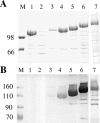S-layer-mediated display of the immunoglobulin G-binding domain of streptococcal protein G on the surface of Caulobacter crescentus: development of an immunoactive reagent
- PMID: 17384306
- PMCID: PMC1907123
- DOI: 10.1128/AEM.02900-06
S-layer-mediated display of the immunoglobulin G-binding domain of streptococcal protein G on the surface of Caulobacter crescentus: development of an immunoactive reagent
Abstract
The immunoglobulin G (IgG)-binding streptococcal protein G is often used for immunoprecipitation or immunoadsorption-based assays, as it exhibits binding to a broader spectrum of host species IgG and IgG subclasses than the alternative, Staphylococcus aureus protein A. Caulobacter crescentus produces a hexagonally arranged paracrystalline protein surface layer (S-layer) composed of a single secreted protein, RsaA, that is notably tolerant of heterologous peptide insertions while maintaining the surface-attached crystalline character. Here, a protein G IgG-binding domain, GB1, was expressed as an insertion into full-length RsaA on the cell surface to produce densely packed immunoreactive particles. GB1 insertions at five separate sites were expressed, and all bound rabbit and goat IgG, but expression levels were reduced compared to those of wild-type RsaA and poor binding to mouse IgG was noted. To remedy this, we used the 20-amino-acid Muc1 peptide derived from human mucins as a spacer, since insertions of multiple tandem repeats were well tolerated for RsaA secretion and assembly. This strategy worked remarkably well, and recombinant RsaA proteins, containing up to three GB1 domains, surrounded by Muc1 peptides, not only were secreted and assembled but did so at wild-type levels. The ability to bind IgG (including mouse IgG) increased as GB1 units were added, and those with three GB1 domains bound twice as much rabbit IgG per cell as S. aureus cells (Pansorbin). The ability of recombinant protein G-Caulobacter cells to function as immunoactive reagents was assessed in an immunoprecipitation assay using a FLAG-tagged protein and anti-FLAG mouse monoclonal antibody; their performance was comparable to that of protein G-Sepharose beads. This work demonstrates the potential for using cells expressing recombinant RsaA/GB1 in immunoassays, especially considering that protein G-Caulobacter cells are more cost-effective than protein G beads and exhibit a broader species and IgG isotype binding range than protein A.
Figures




Similar articles
-
Cell-surface display of a Pseudomonas aeruginosa strain K pilin peptide within the paracrystalline S-layer of Caulobacter crescentus.Mol Microbiol. 1997 Oct;26(2):277-88. doi: 10.1046/j.1365-2958.1997.5711932.x. Mol Microbiol. 1997. PMID: 9383153
-
Linker mutagenesis of the Caulobacter crescentus S-layer protein: toward a definition of an N-terminal anchoring region and a C-terminal secretion signal and the potential for heterologous protein secretion.J Bacteriol. 1997 Feb;179(3):601-11. doi: 10.1128/jb.179.3.601-611.1997. J Bacteriol. 1997. PMID: 9006010 Free PMC article.
-
S-layer anchoring and localization of an S-layer-associated protease in Caulobacter crescentus.J Bacteriol. 2007 Mar;189(6):2226-37. doi: 10.1128/JB.01690-06. Epub 2007 Jan 5. J Bacteriol. 2007. PMID: 17209028 Free PMC article.
-
Alkaline phosphatase and a cellulase reporter protein are not exported from the cytoplasm when fused to large N-terminal portions of the Caulobacter crescentus surface (S)-layer protein.Can J Microbiol. 1994 Sep;40(9):777-82. doi: 10.1139/m94-122. Can J Microbiol. 1994. PMID: 7954110
-
Protein localization during the Caulobacter crescentus cell cycle.Curr Opin Microbiol. 1998 Dec;1(6):636-42. doi: 10.1016/s1369-5274(98)80108-2. Curr Opin Microbiol. 1998. PMID: 10066543 Review.
Cited by
-
Targeted drug delivery using genetically engineered diatom biosilica.Nat Commun. 2015 Nov 10;6:8791. doi: 10.1038/ncomms9791. Nat Commun. 2015. PMID: 26556723
-
Surface-layer protein from Caulobacter crescentus: expression, purification and X-ray crystallographic analysis.Acta Crystallogr F Struct Biol Commun. 2016 Sep;72(Pt 9):677-80. doi: 10.1107/S2053230X16011638. Epub 2016 Aug 9. Acta Crystallogr F Struct Biol Commun. 2016. PMID: 27599857 Free PMC article.
-
Heterologous protein display on the cell surface of lactic acid bacteria mediated by the s-layer protein.Microb Cell Fact. 2011 Oct 28;10:86. doi: 10.1186/1475-2859-10-86. Microb Cell Fact. 2011. PMID: 22035337 Free PMC article.
-
Construction of Lasso Peptide Fusion Proteins.ACS Chem Biol. 2016 Jan 15;11(1):61-8. doi: 10.1021/acschembio.5b00745. Epub 2015 Oct 29. ACS Chem Biol. 2016. PMID: 26492187 Free PMC article.
-
"De-novo" amino acid sequence elucidation of protein G'e by combined "top-down" and "bottom-up" mass spectrometry.J Am Soc Mass Spectrom. 2015 Mar;26(3):482-92. doi: 10.1007/s13361-014-1053-2. Epub 2015 Jan 6. J Am Soc Mass Spectrom. 2015. PMID: 25560987 Free PMC article.
References
-
- Akerström, B., E. Nielsen, and L. Bjorck. 1987. Definition of IgG- and albumin-binding regions of streptococcal protein G. J. Biol. Chem. 262:13388-13391. - PubMed
-
- Bhatnagar, P. K., A. Awasthi, J. F. Nomellini, J. Smit, and M. R. Suresh. 2006. Anti-tumor effects of the bacterium Caulobacter crescentus in murine tumor models. Cancer Biol. Ther. 5:485-491. - PubMed
-
- Bingle, W. H., K. D. Le, and J. Smit. 1996. The extreme N-terminus of the Caulobacter crescentus surface-layer protein directs export of passenger proteins from the cytoplasm but is not required for secretion of the native protein. Can. J. Microbiol. 42:672-684. - PubMed
-
- Bingle, W. H., J. F. Nomellini, and J. Smit. 1997. Cell-surface display of a Pseudomonas aeruginosa strain K pilin peptide within the paracrystalline S-layer of Caulobacter crescentus. Mol. Microbiol. 26:277-288. - PubMed
Publication types
MeSH terms
Substances
LinkOut - more resources
Full Text Sources
Other Literature Sources
Research Materials
Miscellaneous

